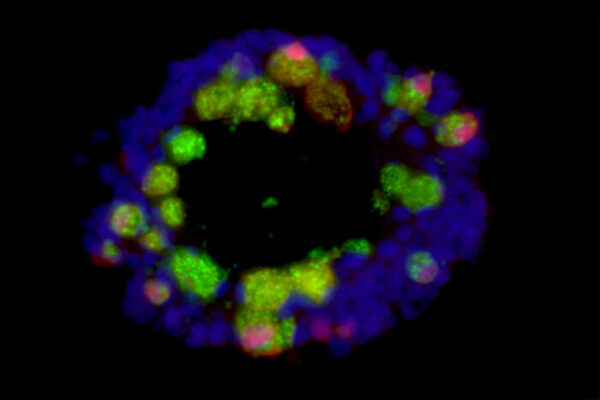Researchers at Washington University School of Medicine in St. Louis have received two grants from the National Institutes of Health (NIH) totaling more than $5.5 million to develop new treatments for two types of devastating parasitic infections common in sub-Saharan Africa and Central and South America: river blindness and intestinal worm infections.
Both are classified as neglected tropical diseases by the World Health Organization (WHO). Such diseases are concentrated among people living in poverty in tropical or subtropical climates, where resources to develop new treatments are often lacking.
One project will focus on onchocerciasis, a roundworm parasite that causes river blindness. Onchocerciasis infections are spread by black flies that thrive near fast-moving rivers. About 270,000 people have become blind, and 1.2 million are visually impaired by river blindness. Current drugs are limited in that they only prevent transmission of the parasite and can’t eliminate an established infection.
The second project will target a broad group of infections caused by intestinal helminth parasites, including hookworm, roundworm and whipworm. These helminths are transmitted through soil and can cause malnutrition and anemia, especially in children and other vulnerable populations. Current therapies are losing their effectiveness as these worms develop resistance to the drugs long used to treat and control the parasites. About 1.5 billion people worldwide are infected with soil-transmitted helminths, according to the WHO.
Both drug-development projects build on past research led by Makedonka Mitreva, co-principal investigator of the new grants and professor of medicine and of genetics. Mitreva, who has conducted studies to understand the genetics and biology of these parasites, is collaborating with co-principal investigator and medicinal chemist James W. Janetka, professor of biochemistry and molecular biophysics, to design new, small molecule drugs to combat these debilitating infections.
“We are pleased to be doing this type of global health research, seeking new treatments for infections that tend to be neglected in terms of the amount of research and funding dedicated to them, even as they affect so many millions of people,” Mitreva said. “We are taking advantage of all the genomic data that we have generated for these parasite species over the last two decades in order to find new ways to target them with medical therapies.”
Collaborators also include a team that studies soil-transmitted helminths. That team is led by Raffi Aroian at the University of Massachusetts T.H. Chan School of Medicine. Other collaborators, led by Sara Lustigman, head of the Laboratory of Molecular Parasitology at the Lindsley F. Kimball Research Institute, the research branch of New York Blood Center Enterprises, are studying onchocerciasis.
The researchers’ aim is to attack elements of the parasite’s metabolism that are essential for the survival of the organism, with the goal of finding drugs that may be able to attack more than one species of parasite at once. For river blindness, they primarily are seeking new treatments that can kill the adult parasites, since current therapies only target the larval stages of the parasite’s life cycle.
“We have identified some potentially promising therapeutic targets that interfere with the way the organisms process energy or carry out other tasks necessary for survival,” Janetka said. “We’re going after some innovative targets that are relatively new treatment strategies, especially for parasitic worms. It’s possible that a drug we develop could inhibit all the worms. A pan-parasitic worm therapy would be wonderful, but there also will be the potential to develop more than one drug, each optimized for different species.”
Recent studies by Mitreva, Janetka and their colleagues have identified existing drug compounds, including some that are approved by the Food and Drug Administration (FDA) to treat other conditions, that show promise in their potential to treat these parasitic infections. A number of these drugs inhibit what the researchers call chokepoint enzymes, or proteins that are essential to the survival of the organism. When chokepoint enzymes are blocked or eliminated, the parasite dies, making these drugs attractive possibilities for new therapeutics. Such FDA-approved drugs also could be used as starting points to design even more specific and targeted therapies for these parasites to ensure that any possible side effects are minimized.
“That fact that many of these drug candidates are already FDA approved could speed up the drug development process considerably,” Janetka said.
Added Mitreva, “The World Health Organization has a goal of eliminating river blindness by 2030, and we believe developing effective treatments against the adult worms — not just targeting the spread of the infection — will be required to meet this goal. We have some promising drug targets and look forward to developing new treatments for these debilitating infections that impact so many lives around the world.”
This work is supported by the National Institutes of Health (NIH), grant numbers R01EY033195 and R01AI159450.
Washington University School of Medicine’s 1,700 faculty physicians also are the medical staff of Barnes-Jewish and St. Louis Children’s hospitals. The School of Medicine is a leader in medical research, teaching and patient care, and is among the top recipients of research funding from the National Institutes of Health (NIH). Through its affiliations with Barnes-Jewish and St. Louis Children’s hospitals, the School of Medicine is linked to BJC HealthCare.



